HAYAO MIYAZAKI ANIME
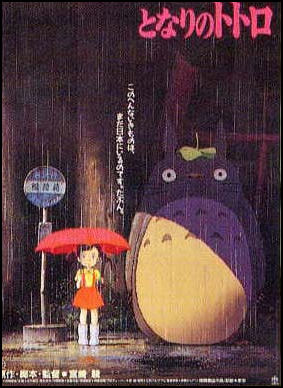
Totoro Hayao Miyazaki is Japan's most famous anime film maker. He is almost as well known in Japan as Walt Disney is in the United States. His films are widely praised for tackling ambitious themes, dealing with them in complex ways and producing images and action that take your breath away. [Source: Margaret Talbot, The New Yorker, January 17, 2005]
John Lasseter, the maker of “Toy Story” and “Bugs Life”, told the New York Times, "Not a day goes by that I do not utilize the tools learned from studying his films...Watch one of his films and it's like, whoa, look what he did. It's inspiration to power." He told he The New Yorker, “He has such a big heart; his characters and his worlds are so rich.” Barry Cook and Tony Cook, the animators behind “Mulan” said, "Miyazaki is like god to us.”
Miyazaki was on the Time list of “most influential people” in 2005 and was given a lifetime achievement Golden Lion at the Venice Film Festival. He was described by Margaret Talbot in The New Yorker as “the auteur of anime” and “perhaps the most adored animation director in the world.” “Miyazaki is a master of conveying emotions as a child would experience them; obliquely, often physically, with thread of magical thinking that promotes resilience,” Talbot wrote.
Miyazaki and his team work at Studio Ghibli outside of Tokyo. Christoph Mark wrote in the Daily Yomiuri,”Whenever Studio Ghibli puts out a new film audiences go in knowing what to expect: a well-crafted, thought-provoking and enduring soon-to-be classic”
Websites and Resources
Good Websites and Sources: Hayao Miyazaki on Anime News Network animenewsnetwork.com ; The Hayao Miyazaki Web nausicaa.net/miyazaki ; Ghilbi World.com ghibliworld.com ; Hayao Miyazaki Video Biography YouTube ; Online Ghibli onlineghibli.com ; Rotten Tomatos Profile rottentomatoes.com/celebrity/hayao_miyazaki ; Ghibli Museum in Tokyo ghibli-museum.jp ; Photos and Background Information tautoz.com ; Japan Guide japan-guide.com; Book: “Hayao Miyazaki: Master of Japanese Animation” by Helen McCarthy (1999, Stone Bridge Press).
Links in this Website: MANGA Factsanddetails.com/Japan ; POPULAR TYPES OF MANGA Factsanddetails.com/Japan ; POPULAR MANGA AND FAMOUS MANGA ARTISTS Factsanddetails.com/Japan ; MANGA FANS AND COSPLAY IN JAPAN AND ABROAD Factsanddetails.com/Japan ; OSAMU TEZUKA, MANGA AND ANIME Factsanddetails.com/Japan ;ANIME Factsanddetails.com/Japan ; ANIME FILM AND TELEVISION SHOWS Factsanddetails.com/Japan ; HAYAO MIYAZAKI ANIME Factsanddetails.com/Japan ; MODERN JAPANESE FILM INDUSTRY Factsanddetails.com/Japan ; MODERN JAPANESE FILMMAKERS AND FILMS Factsanddetails.com/Japan ; MEDIA, RADIO, NEWSPAPERS AND TELEVISION IN JAPAN Factsanddetails.com/Japan ; TELEVISION PROGRAMS IN JAPAN Factsanddetails.com/Japan ; CHILDREN’s TELEVISION SHOWS IN JAPAN Factsanddetails.com/Japan ;
Good Anime Websites and Sources: Crunchyroll crunchyroll.com . Crunchyroll is an Internet portal for anime downloads that began as a free fan file-sharing site and grew into a for-profit site that charges users fees that go to the producers of the anime. Free Anime Streams on Watch Anime watchanimeon.com ; Free Anime Streams on Zomganime.com zomganime.com ; Wikipedia article Wikipedia ; Tokyo International Anime Festival tokyoanime.jp ; Anime News Network animenewsnetwork.com ; Anime Books: “Anime: from Akira to Howl’s Moving Castle” by Susan J. Napier (Palgrave, 2001); “The Anime Companion” by Gilles Poitras (Stone Bridge Press, 1999); “Anime Revolution” by Ian Condry, a Harvard professor; “Rough Guide to Anime” by Briton Simon Reynolds.
Articles and Essay on Anime: Essay on Manga and Anime aboutjapan.japansociety.org ; Useful Filmography on Anime aboutjapan.japansociety.org ; Essay on Teaching Anime aboutjapan.japansociety.org ; Essay on Dawn of Anime aboutjapan.japansociety.org ; Anime Blogs Random Curiosity randomc.animeblogger.net ; The Anime Blog theanimeblog.com ; Japan Underground Blog hamblogjapan.blogspot.com ; Anipike anipike.com/ ;
Places That Sell Anime Right Stuf Anime Superstore rightstuf.com ; Anime Corner animecornerstore.com ; Anime Nation animenation.com ; Krazy World of Manga, Anime and Video Games, Japanese, Chinese and Korean CDs and DVDs at Yes Asia yesasia.com ; Japanese, Chinese and Korean CDs and DVDs at Zoom Movie zoommovie.com ; Animax is a satellite channel that specializes in anime. It debuted in 1998 and claims 41 million viewers in Japan and is broadcasts in 46 other countries. Among the classic that are featured are “Dragonball Z”, “Mobile Suit Gundam”, “Astroboy”, and “Lupin III”. Animex is owned by Sony. The Cartoon Network exclusively airs Japanese anime after midnight.
Miyazaki's Life
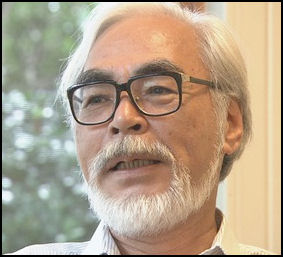
Miyazaki was born in 1941 into a wealthy family. His father was the head of a company that made parts for Japanese Zero fighters and other airplanes. Some of his earliest memories were of drawing airplanes. When he first began having ambitions of being animator he realized he wasn't very good at drawing people.
Miyazaki attended Gakishuin University. He studied political science and economics and became a Marxist, and remained one until the 1980s. Miyazaki saw his first animated feature, “Legend of the White Serpent”, when he was in high school and was a member of children’s literature study group in university. In 1963, he joined the staff of Toei Doga, the largest animation studio in Asia, which primarily made programs for television. He met his wife, an animator named Akemie, at Toei. They had two sons: one is now a landscape designer and animator (See Below), and the other, an artist who specialized in wood engravings.
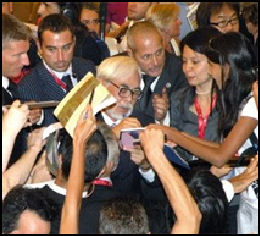
mobbed in Venice in 2008 At Toei, Miyazaki worked on anime films and animated television shows like “Sherlock Holmes, Horus: Prince of the Sun” and “The Dog of Flanders”. He eventually left Toei and joined another company, Nippon Animation, where he was the key artist and set designer for the popular television series “Heidi” and “Panda! Go Panda!”” Then in 1985, he founded the animation company Studio Ghibli with his long time associate Isao Takahara.
Miyazki is known for his obsessiveness and distaste for the modern world. He once traveled to Portugal to check out a single Hieronymus Bosch painting that had long fascinated him, often works from 8:00am to 2:00am and likes to lament on the loss of nature and the sense of wonder lost in children’s lives. He would like to see kids spend less time watching DVDs and playing video games and worries about his contribution to the problem.
Ghibil particpated in protests against nuclear power displaying an anti-nuclear power banner at its headquarters.
Miyazaki on Filmmaking
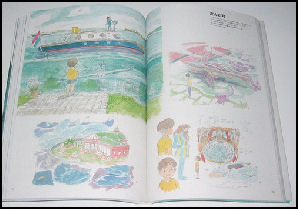
Drawings from Ponyo Miyakaki once said, "I believe we must betray the expectations of the audience in order to keep them. The best thing is to try to make a movie that you don’t have a clue how to make." Another time he said, "I have never made a film trying to get approval from the audience or to cheer the audience.”
Miyazaki is known as a perfectionist who does not leave all the work to his assistants (as was the case with Walt Disney). He often draws many of the frame cells himself and has his hand in those he doesn't. In “Princess Monoke” he reportedly applied some pencil and ink to nearly 80,000 of the films 144,000 cell frames.
Miyazaki has expressed his dislike for computer graphics which he feels lack the humanity and fluidity necessary for his stories. Digital technology is usually only brought on Miyazaki films for complex three-dimensional sequences.

Miyazaki's car Miyazaki is equally famous for action-packed battle and flying scenes and his vivid landscapes that look as of they were created by a Impressionist painter not an animation artist. Most of films center around strong, independent young girls.
On the fact that so many of his films feature world-encompassing disasters Miyazaki told Japanese pop culture expert Roland Kelts, “Disasters are things to be lived through. They’re not evil. They bring people closer together. In fact, when I go to the top of a skyscraper in Tokyo, I feel the hope that the seas will come a little closer. It would be wonderful if I could see the end of civilization in my lifetime, but it doesn’t look like it’s going to happen. So I have to use my imagination.”
Miyazaki on Life
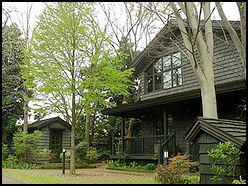
Miyazaki's house Miyazaki often speaks out on the negative impact of cell phones, video games and television and how they breed pessimism and get in the way of appreciating nature and life — and admits to his own role in generating interest in virtual world rather than real ones. “In our country,” he said, “a sense of balance seem to have crumbled down so that there is no place where we can take care of sheep or cattle or run around barefoot. Rather we are surrounded by a virtual environment.”
“I think there are things that children have to learn before they can read and write. And these are the things, which people during the Stone Age were able to do. In other worlds, to create fire and to be able to maintain that fire and to extinguish that fire, and also to understand the nature of water, and to climb up trees and be able to use ropes and be able to use a knife.” He has said he thinks the government should take an active role a teaching these skills.
Miyazaki's Early Films
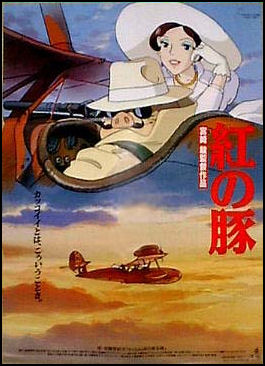
Porco Rosso Miyazaki released his first feature, “Castle of Cagliostro”, about a hero-scoundrel, in 1979. He first drew international attention as animator with “Nausicaa of the Valley of the Wind” (1984), a film about a young girl battles giant insects, monsters and tribes in a future world poisoned by industrial waste. The film generated enough money and publicity for Miyazaki to found Studio Ghilbi.
Films made by Miyazaki in the late 1980s were “Laputa: The Castle in the Sky” (1986), a science fiction adventure with impressive action scenes; “My Neighbor Totoro” (1988), about children who move to the countryside and discover a world of forest spirits; and “Kiki's Delivery Service” (1989), a humorous action adventure about a sweet-hearted, 13-year-old witch that must leave her family and move to a new town as part of her training, taking only her black cat, broom and radio with her. It was the highest grossing film in 1989.
The great Japanese director Akira Kurosawa once said “My Neighbor Totoro” (“Tonari no Totoro” in Japanese) was one of his favorite films. It is a story of two sisters taken to the countryside by their father while their mother is hospitalized with a serious illness. While exploring their environment they come in contact with a number of magical creatures, including the Totoro characters in the title.
In 2008, Pixar hosted the Totoro Park Art Auction. A total of 190 artists from 20 countries, including some from Pixar, Disney, Lucas Works and Dreamworks provided art work and to help preserve Sayama Forest on the border of Tokyo and Saitama Prefecture , the setting for “My Neighbor Totoro”. The auction raised roughly $200,000.
Miyazaki scored a huge success with “Porco Rosso” (1992), a strange film about a biplane pilot with a pig's face that flies around the Mediterranean battling smugglers. He also made the “Hesei Tanuki Wars” and “Memories Crumbling Down” and went to Europe to try to secure the rights to “Pippi Longstockings” but failed.
“Hesei Tanuki Wars” (“Hesei Tanuki Gassen Ponpoko” in Japanese) is set in the Tama Hills west of Tokyo, where tanuki habitat is being replaced by a housing project. The tanukis (raccoon-like animals) use their magic to try to get their land back but eventually are forced to change into humans to survive.
Princess Mononoke

“Princess Mononoke” (1997) is regarded as a Miyazaki masterpiece. Visually-stunning and often violent, it was the most successful Japanese-made movie of all time, until it was surpassed by Miyazaki's own “Spirited Away”. Made at a cost of $20 million, it grossed $150 million in Japan and was viewed by 11 million people there in the first eleven weeks after it was released. It went on to gross around $200 million internationally. Miyazaki devoted three years to film and was so exhausted when it was finished he talked about retiring.
Set in 14th century Japan, and inspired partly by old folk tales, “Princess Mononoke” is about girl, known both as Princess Mononoke and San, who is raised by elephant-size wolves and polka-dotted wild boars, and Ashitaka, a young boy who receives a curse from a demon boar and seeks out the Great Deer God of the Forest, who can lift the curse. During his quest for the god Ashitaka runs into San.
“Princess Mononoke” has a strong environmental theme centered around the overuse of natural resources and development. Sen battles environmentally-unfriendly villagers who want to destroy the forest where she lives to provide fuel for an iron forge. The forest is the last of its kind, and is jealously protected by wolves and spirits, in world where all the other forest have been cut down. The movie ends with an epic battle between mankind and nature that leaves the world in ruins.
“Princess Mononoke” is loosely based on one episode of the Gilgamish story from ancient Mesopotamia. In this episode a growing urban areas requires resources from a forest but is unable to gain access to it until the guardian deity Funbaba is driven out. Gilgamish and his sidekick Enkidu fight with a kill Funbaba.
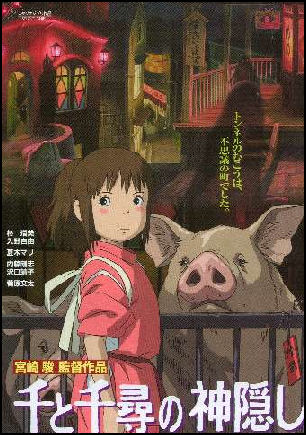
“Princess Mononoke” was the first of Miyazaki's films to be dubbed in English. Great care was taken to get a good English script. Well-known Hollywood actors were brought in to do the voices. Claire Danes is San and Billy Grudup is Ashitaka. Other voices were provided by Billy Bob Thornton, Gillian Anderson and Minnie Driver. The film did well in the United States even though many regarded it as too long (2¼ hours), slow, dark, thoughtful and unresolved for American audiences. Disney backed the films even though it doesn't have a happy ending.
Spirited Away
“Spirited Away” (2001) broke box office records set by “Princess Mononoke” and “Titanic” and became the biggest box office success ever in Japan. It brought in more than $300 million in Japan.
“Spirited Away” is about a young girl, Chihiro, who leaves her home to move to a new city with her parents by car. One the way they take a wrong turn and pass through a mysterious tunnel into a strange village. Chihiro's parents enter a restaurants where they eat too much and become pigs. Chihiro is then left by herself to sort things out in a village, which it turns out is resort for a variety of exhausted spirits and gods.
“Spirited Away” won the Academy Award in 2003 for Best Animated Feature Film and also was the winner of the prestigious Golden Bear at the Berlin Film Festival in 2002. It was the first Japanese feature film to win an Academy Award since 1955 and was the first animated film to take the top prize in Berlin. Miyazaki didn’t attend either award ceremony because he was busy on other projects. In a press conference he downplayed the success of “Spirited Away” and called it “just another film.”
Later Miyazaki Films

Ponyo Later Miyazaki films include “The Cat Returns” (2002) and “Howl’s Moving Castle” (2004). The latter was selected as the best animated film of 2005 by the New York Film Critics Circle and was awarded the Osella prize for outstanding technical contribution at the Venice International Film festival.
“Howl’s Moving Castle” (“Hauro no Ugoku Shiro” in Japanese) is the story of an 18-year-old young girl who is caste into the body of a 90-year-old woman by an evil Witch of Waste and is based on a book by British author Diana Wynne Jones. After the girl’s transformation she flees from her job in a hat shop and find herself in the moving castle of handsome wizard named Howl, who she falls in love with.
In 2006 Miyazaki released three short films: “Mizugumo Monmon” (“Mon Mon, the Water Spider”), a 15-minute short about the love and adventures of a water spider; “Yadosagashi” (“House Hunter”), a 12-minute film about a girls searching for a new home; and “Hoshi o Katta Hi” (“The Day I Bought a Star”), a 16-minute fantasy created by the painter Naoshisa Inoue.
Miyazaki’s “Ponyo on the Cliff by the Sea”was released in 2008 and shown at the Venice Film Festival. Loosely based on the “The Little Mermaid” and aimed almost entirely for little children, it is about a 5-year-old boy named Sosuke who befriends a fish girl who falls for Sosuke and wants to become human.
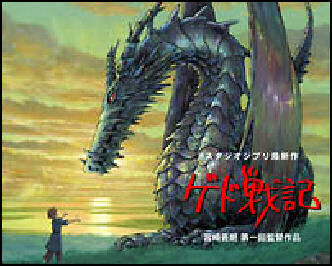
Tales of Earthsea by Miyazaki's son In recent years Ghibli has shied away from original material and instead done adaptations of already much-loved children’s stories. “Karigurashi no Arrietty” (“The Borrower’s Arrietty”) was released by Ghibli in 2010. Based in a 1952 children’s story by Mary Norton and a screenplay by Miyazaki and made by Ghibli animator Hiromasa Yonebeyashi in his directorial debut, it is about a 10-centimeter-tall 13-year-old girl named Arrietty and her equally small father Pod and mother who enrich their world, as do other Borrowers, by borrowing stuff from the human world above but at all cost must avoid being seen by humans. This arrangement is disrupted when Arrietty is spotted by a young boy with a heart problem named Sho.
Christoph Mark wrote in the Daily Yomiuri, “The film is told almost entirely from the point of view of Arrriety and her family, both in terms of story and stature. In fact, it would not be surprising to learn that Ghibli spent more time on sound effects and creative “set design” in this film than with any of its previous efforts. Drops of water loom large and drip like syrup; the ticking of a clock reverberates through the floor and the theater’s speakers; tissue paper is large and stiff.”
In the summer of 2011 Ghibli is planning to release a new film — “Kokurikozaka Kara” (“Kokuriko Hill”) — based on a 1980 manga about high school girls in Yokohama in the 1960s when Japan was experiencing spectacular growth. The film is directed by Goro Miyazaki, the son of Hayao.
Ghibli Studios and Miyazaki’s Son
Ghibli studios is the studio founded by Miyazaki and the place he works. It is known for its attention to detail and its natural look and putting a great deal of time and effort into each project. In Ghibli films you can see the wind gently pushing tall summer grass, shadows of clouds roaming the landscape and beams of light lightly highlighting important objets. An examination of layout sketches produced by the studio reveal the amount of work that goes into creating each frame and give therm their rich, detailed, look.
Among those wgo who have worked at Ghibli are Nizo Yamamoto, the art director of film like “Pricess Mononoke” and “Grave of the Fireflies”; Kazuo Oga, who spent his entire career painting backgrounds for films produced by Studio Ghibli. A one time sign painters Oga began working with Miyazaki in the 1980s, his work is so highly regarded that it has drawn praise from film critic Roger Egbert and been exhibited at art galleries.
In February 2008, Koji Hoshino, a former executive at Disney was named president of Ghibli, He was brought in part because of his experience marketing videos and DVDs.
Hayao Miyazaki’s son Goro Miyazaki graduated from university with a degree in forestry sciences. In 2006, at the age of 39, he released his first animated film. “Gedo senki” (“Tales from Earthsea”) that was good for a debut and did well att the box office.
Kokuriko-zaka Kara, 2011 Miyazaki-Ghibli Film
“Kokuriko-zaka Kara” (English title: From Poppy Hill) is a Ghibil film released in the summer of 2011 written by Hayao Miyazaki and directed by his son Goro Miyazaki. Takashi Kondo wrote in the Yomiuri Shimbun, “Set in 1963, the latest Studio Ghibli offering, Kokuriko-zaka Kara, is filled with many experiences that have been lost in our daily life. Among these, the scene where the protagonist, Umi, begins her day stands out. Wearing an old-fashioned apron, the high school girl is preparing breakfast. She cooks rice in a traditional pot and puts the cooked rice in a wooden container. Her younger sister, brother and the residents of the boarding house where Umi works all sit around the table and have their meal. This communal dining experience was common in Japan when living in an extended family was the norm. [Source: Takashi Kondo, Yomiuri Shimbun, July 15, 2011]
The school Umi goes to also exudes a feeling of years gone by. The scenes are filled with nostalgia-inducing items such as a white sailor-style school uniform for girls, military-style, stiff-collared jackets and school caps for boys and a mimeographed school newspaper. Such images portray the old days--a serious but gentler era. The images on screen evoke the viewers' sense of nostalgia, drawing out a yearning to go back to the simpler time.
The supporting characters include odd members of the school's philosophy and astronomy clubs who make their base in an old wooden house called "Quartier Latin." The romantic relationship between Umi and Shun, a member of the school's newspaper production staff, also contributes to the nostalgic atmosphere. While double riding on a bicycle, Umi leans over Shun's shoulder, or eats a croquette that Shun bought for her. It is easy to see that they openly enjoy being with each other and every little thing the young couple do oozes with a fresh, youthful innocence.
Watching this movie, some will recall their own memories of 1963--the year before the Tokyo Olympic Games--when Japan embraced the beginning of the economic boom. As they watch, viewers will probably feel comforted as they find themselves wrapped up in sentimentality. But this is not just a saccharine movie coated with a veneer of nostalgia. As the story unfolds, the audience learns that Umi and Shun are the ones who struggle to keep vanishing memories while trying to regain the lost ones.
The story develops around the couple's two important memories--the layers of cultural memories in the Quartier Latin house and the memories that give clues to the births of Umi and Shun. The students of Quartier Latin rebel against the school that is trying to knock down the old house, while the young couple are tracing back the memories of their fathers who died during the war, with doubts creeping in that they might be half brother and sister.
The film portrays their struggle and their suffering as they fear they may forget about their lost fathers, and it is heart-breaking and painful to watch. That's why the words that later credit the memory of their fathers will definitely move the audience.
Among the many things that we have long lost, this movie repeatedly shows the images of those who are looking up. The flag, portrayed as a symbol of the late father, is raised high, the Quartier Latin house is viewed against a backdrop of sky, while the boarding house is on the top of a hill. Living in this environment, the characters naturally look up. Although not overtly stated, the message, "Walk with your head up," is a clear visual image. Using such a straightforward method works very well throughout the story.
Hayao Miyazaki was in his 20s in 1963 and that influence is seen in the anime script he wrote. His son, Goro, who was not even born in the early 1960s, directed it. The father-son joint production achieved a wonderful result and Kokuriko-zaka Kara is a work that needs to be seen in this day and age.
Image Sources: Ghibli Studio, Japan, Zone, Hector Garcia website, YouTube
Text Sources: New York Times, Washington Post, Los Angeles Times, Daily Yomiuri, Times of London, Japan National Tourist Organization (JNTO), National Geographic, The New Yorker, Time, Newsweek, Reuters, AP, Lonely Planet Guides, Compton’s Encyclopedia and various books and other publications.
Last updated October 2011
